 System Tutorial
System Tutorial
 Windows Series
Windows Series
 How to disable the built-in administrator account in Win10? Tips for turning off the built-in administrator in Win10
How to disable the built-in administrator account in Win10? Tips for turning off the built-in administrator in Win10
How to disable the built-in administrator account in Win10? Tips for turning off the built-in administrator in Win10
Win10 system comes with a built-in administrator account, which poses a potential risk to system security. If you want to disable the built-in administrator account, you need to proceed with caution. In this article, PHP editor Xigua introduces you to the techniques of disabling the built-in administrator in Win10, allowing you to easily master the operation method and ensure system security.

1. Understand the built-in administrator account
In the Win10 system, the built-in administrator account is an account with the highest authority and can perform system configuration, Install software, change other users' settings, etc. By default, this account is disabled and needs to be manually enabled by the user. However, some users may feel that it is unnecessary after enabling this account and hope to disable it to improve system security.
2. Method to disable the built-in administrator account
Method 1:
1. Open the command prompt
Open the command prompt as an administrator , the method is as follows:
- Right-click the start menu and select "Run";
- Enter "cmd", then click "OK" or press Enter.
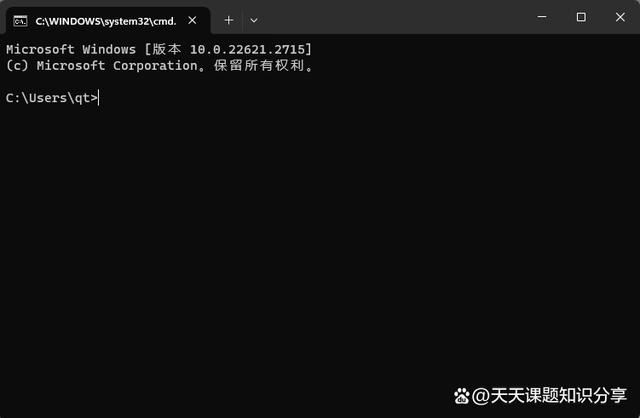
2. Execute the command
In the command prompt window, enter the following command and execute:
net user administrator /active:no
This command means to set the administrator account to an inactive state, that is, to disable it.
3. Confirm the operation
After executing the above command, the administrator account will be disabled. In order to confirm whether the operation is successful, you can try to log in to the system with the username "administrator" and password (if a password is set). If the login fails, the built-in administrator account has been successfully disabled.
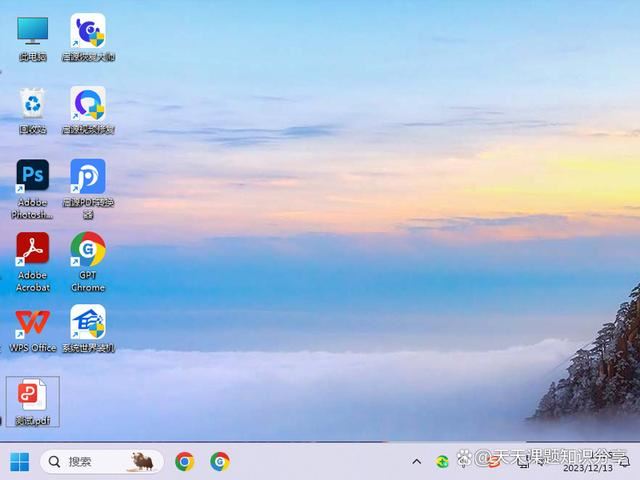
#All versions of Windows include a built-in administrator account that provides complete unrestricted access to the PC. By default, the built-in Administrator is disabled and hidden. If you want to log in, you need to enable it first. Now, this article will show you three simple ways to enable or disable the built-in administrator account in Windows 10.
Note: To enable or disable the built-in administrator, you need to log into Windows 10 with an administrator-level account. If you've lost administrator rights or can't access Windows 10, see how to enable the built-in administrator without logging in.
Method 2: Enable or disable the built-in administrator account in local security policy
This method is only available in Windows 10 Pro and Enterprise editions. When you enable the built-in administrator account, the User Account Control dialog box will not appear when you try to run a program as an administrator.
Step 1: Press Win R to open the Run dialog box. Type secpol.msc and press Enter to open Local Security Policy.

Step 2: In the left pane, click Local Policies > Security Options. In the right pane of the Security Options folder, double-click the policy titled Accounts: Administrator Account Status.
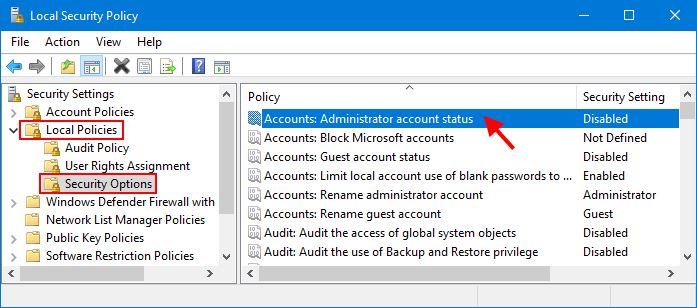
Step 3: When the policy's Properties dialog box opens, you can select Enable or Disable to enable or disable the built-in administrator account. After selecting the desired options, click Apply for the changes to take effect.
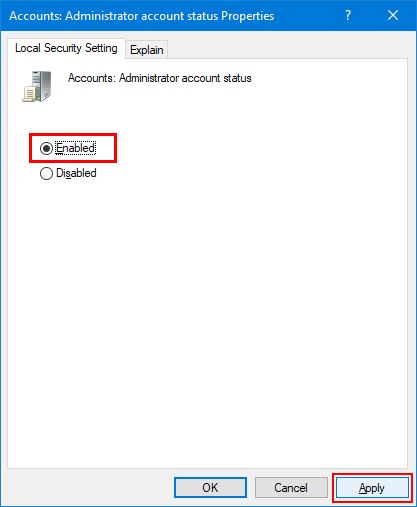
Method three: Enable or disable the built-in administrator account in local users and groups
This option is also only available in Windows 10 Pro and Enterprise editions Available.
Step 1: Use Win R to open the "Run" dialog box, enter lusrmgr.msc and press the Enter key to open "Local Users and Groups".

Step 2: Select the "Users" folder in the left pane, you will see in the middle pane all the user accounts present on the computer, including the built-in Administrator account. Double-click the built-in administrator account, the default name is Administrator.
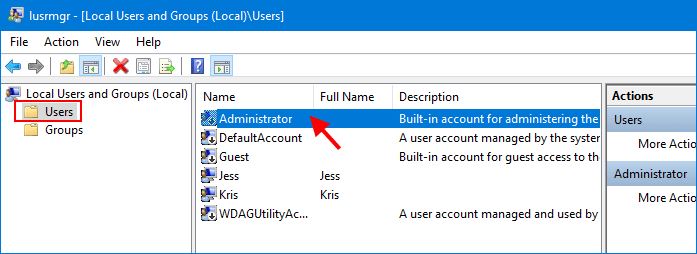
Step 3: Open the built-in administrator properties dialog box. To enable the built-in administrator account, simply uncheck the "Account is disabled" option and click Apply.
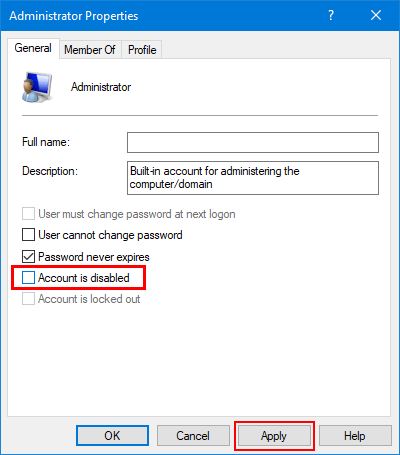
Method Four: Enable or disable the built-in administrator account using Command Prompt
Step 1: Type cmd in the search box next to the Start button . When the Command Prompt shortcut appears in the list of search results, right-click it and select Run as administrator. This will open an elevated command prompt.
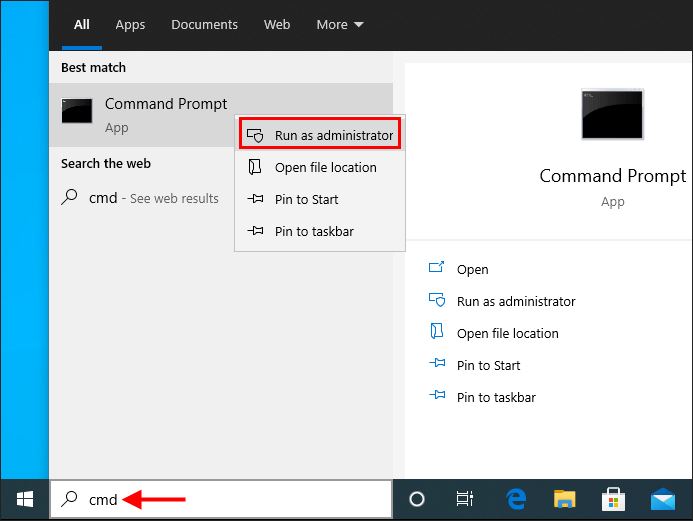
#Step 2: To enable the built-in administrator account, type net user Administrator /active:yes and press Enter. To disable the built-in administrator account, type net user Administrator /active:no and press Enter. Changes will take effect immediately without restarting your computer.
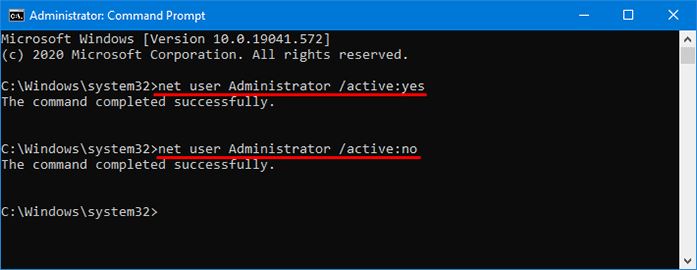
Final words:
The built-in Administrator account has free control over the entire Windows system, making it a security hole. Therefore, in general, it is not recommended to enable the built-in administrator account unless it is really needed. Once the built-in administrator is enabled, it is not recommended to share, rename, or set a password for it.
3. Notes
1. Before performing the disabling operation, please ensure that you have other valid administrator accounts available for system management when needed.
2. If you need to enable the built-in administrator account in the future, you can repeat the above steps and change "/active:no" to "/active:yes".
3. Disabling the built-in administrator account may affect certain functions of the system. For example, administrator privileges may be required when using third-party system tools or software. So before disabling it, make sure you understand the possible repercussions.
Summary: Through the above steps shared by System World, you can easily disable the built-in administrator account of the Win10 system and improve system security. Before performing the operation, please ensure that you have other valid administrator accounts and understand the possible impacts. If necessary, you can also enable the built-in administrator account at any time.
The above is the detailed content of How to disable the built-in administrator account in Win10? Tips for turning off the built-in administrator in Win10. For more information, please follow other related articles on the PHP Chinese website!

Hot AI Tools

Undresser.AI Undress
AI-powered app for creating realistic nude photos

AI Clothes Remover
Online AI tool for removing clothes from photos.

Undress AI Tool
Undress images for free

Clothoff.io
AI clothes remover

AI Hentai Generator
Generate AI Hentai for free.

Hot Article

Hot Tools

Notepad++7.3.1
Easy-to-use and free code editor

SublimeText3 Chinese version
Chinese version, very easy to use

Zend Studio 13.0.1
Powerful PHP integrated development environment

Dreamweaver CS6
Visual web development tools

SublimeText3 Mac version
God-level code editing software (SublimeText3)

Hot Topics
 System Restore prompts that you must enable system protection on this drive
Jun 19, 2024 pm 12:23 PM
System Restore prompts that you must enable system protection on this drive
Jun 19, 2024 pm 12:23 PM
The computer has a restore point, and when the system is restored, it prompts "You must enable system protection on this drive." This usually means that the system protection function is not turned on. System protection is a feature provided by the Windows operating system that can create system restore points to back up system files and settings. That way, if something goes wrong, you can revert to a previous state. When the system fails and you cannot enter the desktop to start it, you can only try the following method: Troubleshooting-Advanced Options-Command Prompt Command 1 netstartvssrstrui.exe/offline:C:\windows=active Command 2 cd%windir%\system32 \configrenSYSTEMsy
 What should I do if win10 does not switch users? Win10 login interface does not have the option to switch users. Solution
Jun 25, 2024 pm 05:21 PM
What should I do if win10 does not switch users? Win10 login interface does not have the option to switch users. Solution
Jun 25, 2024 pm 05:21 PM
A problem that Windows 10 users may encounter is that they cannot find the switch user option on the login interface. So what should I do if there is no switch user option on the win10 login interface? Let this site give users a detailed explanation of the problem of not switching user options in the win10 login interface. Detailed solution to the problem of switching user options on the Win10 login interface: Check user account settings: First, make sure you have multiple user accounts on your computer and that these accounts are enabled. You can check and enable the account by following these steps: a. Press Win+I keys to open Settings and select "Accounts". b. Select "Family & Others" or &ld in the left navigation bar
 How to permanently turn off real-time protection in win10? How to disable real-time protection function in win10 computer 0
Jun 05, 2024 pm 09:46 PM
How to permanently turn off real-time protection in win10? How to disable real-time protection function in win10 computer 0
Jun 05, 2024 pm 09:46 PM
Although the comprehensive anti-virus software that comes with Windows 10 system can continuously protect the security of your personal computer, sometimes it may also affect certain downloaded files. For some users, it may be more appropriate to temporarily turn off the real-time protection function. But many users don’t know how to permanently turn off the real-time protection feature on win10 system. 1. First, press the "Win+R" keys to open the run window, enter the "gpedit.msc" command to open the local Group Policy Editor interface; 2. Then, in the opened interface, click "Computer Configuration/Administrative Templates/ Windows Components/MicrosoftDef
 How to restore the default wallpaper in win10? One trick to quickly restore the default wallpaper in Windows 10 system
Jun 02, 2024 pm 02:07 PM
How to restore the default wallpaper in win10? One trick to quickly restore the default wallpaper in Windows 10 system
Jun 02, 2024 pm 02:07 PM
In Windows 10 system, if you want to return to the system default wallpaper, you can follow the following steps: 1. Right-click a blank space on the desktop and select Personalize in the pop-up menu. 2. This will open the Personalization window in Settings. In the left menu, click Background. 3. Under the "Background" settings, find and click the drop-down menu next to "Choosepicture", and then select Windows Default (Windows Default) or directly select a picture that looks like the default wallpaper in the picture preview below ( if there are multiple options). 4. If your system has multiple versions
 What should I do if Win10 takes a screenshot and crashes? How to solve the problem of Win10 flashing and then disappearing after taking a screenshot?
Jun 02, 2024 pm 12:48 PM
What should I do if Win10 takes a screenshot and crashes? How to solve the problem of Win10 flashing and then disappearing after taking a screenshot?
Jun 02, 2024 pm 12:48 PM
There are many reasons why the screenshot disappears after taking a screenshot in Win10. Users can first check the screenshot save location or adjust the screenshot settings, or check the animation effect to check it. If it really doesn't work, you can also choose to update the driver and operating system to perform the operation. Let this website carefully introduce to users the analysis of the problem of Win10 disappearing after taking a screenshot. Analysis of the problem after win10 takes a picture and it flashes and disappears 1. Check where the screenshot is saved: When you use the Win+PrtSc (PrintScreen) key combination to take a screenshot, the screenshot is usually saved in the C:\Users\YourUsername\Pictures\Screenshots folder. please
 Windows cannot start the Windows Audio service Error 0x80070005
Jun 19, 2024 pm 01:08 PM
Windows cannot start the Windows Audio service Error 0x80070005
Jun 19, 2024 pm 01:08 PM
The guy's computer appears: Windows cannot start the WindowsAudio service (located on the local computer). Error 0x8007005: Access denied. This situation is usually caused by user permissions. You can try the following methods to fix it. Method 1: Modify the registry to add permissions through batch processing, create a new text document on the desktop, save it as .bat, and right-click the administrator to go far. Echo==========================EchoProcessingRegistryPermission.Pleasewait...Echo================== ========subinacl/subkey
 What to do if the Win10 Task Manager crashes? How to fix the Win10 Task Manager crash?
Jun 25, 2024 pm 04:31 PM
What to do if the Win10 Task Manager crashes? How to fix the Win10 Task Manager crash?
Jun 25, 2024 pm 04:31 PM
Hello everyone, have you ever encountered the situation where the Windows 10 Task Manager keeps crashing? This function helps us a lot, allowing us to quickly see all running tasks, which is very convenient to use, right? However, some friends said that they encountered this problem and didn’t know how to solve it, so let me share with you the specific solution! Solution to Win10 Task Manager crash 1. First, press and hold the "Win" + "R" keys on the keyboard to open Run, enter "regedit" and press the Enter key. 2. Expand the folders and find "HKEY_CURRENT_USERSoftwareMicros
 What should I do if there are no pop-up reminders for calendar events in Win10? How to recover if calendar event reminders are gone in Win10
Jun 09, 2024 pm 02:52 PM
What should I do if there are no pop-up reminders for calendar events in Win10? How to recover if calendar event reminders are gone in Win10
Jun 09, 2024 pm 02:52 PM
The calendar can help users record your schedule and even set reminders. However, many users are asking what to do if calendar event reminders do not pop up in Windows 10? Users can first check the Windows update status or clear the Windows App Store cache to perform the operation. Let this site carefully introduce to users the analysis of the problem of Win10 calendar event reminder not popping up. To add calendar events, click the "Calendar" program in the system menu. Click the left mouse button on a date in the calendar. Enter the event name and reminder time in the editing window, and click the "Save" button to add the event. Solving the problem of win10 calendar event reminder not popping up





